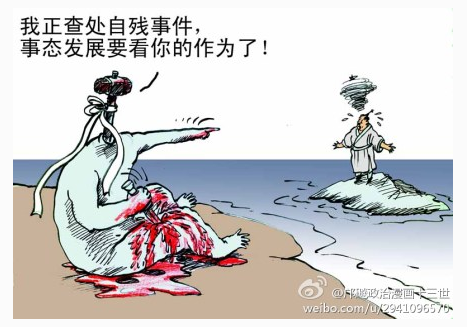
In early September 2012, Japan’s government announced its intention to buy the uninhabited Senkaku Islands, which China claims and calls the Diaoyu Islands, from a private owner. The move sparked anger across China, and by September 15 protests in many cities across China had grown violent. Mobs attacked Japanese factories, Japanese-brand stores and even stores stocking Japanese products. Images of Japanese-brand cars smashed and overturned — cars purchased by China’s newly rich — were shared widely on Chinese social media. Even more disturbing were the extreme messages. Many images showed protesters holding up banners reading: “Even if all China becomes a grave, we must kill all Japanese.” The madness of nationalism seemed to override the instinct for self-preservation. In this cartoon, posted by artist Kuang Biao (邝飚) to Sina Weibo on September 18, 2012, a figure with a hammer for a head and sporting a bandana like that worn by some Chinese protesters in recent days, sits on the Chinese mainland, slashing itself violently with a knife. It screams across the East China Sea to a clearly Japanese figure standing atop a tiny island, symbolizing the Senkaku Islands: “I’m looking into this case of self-mutilation! How things develop depends on what you do!” The Japanese figure looks utterly flabbergasted at the behavior he sees across the water, his expression seeming to say, “WTF!”




















